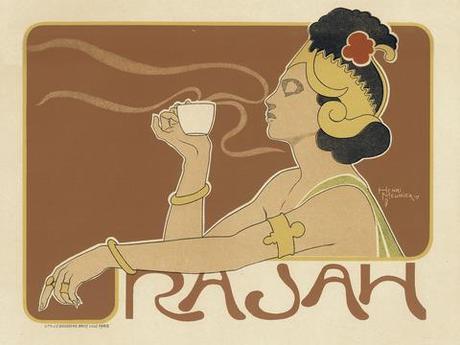
Is there more caffeine in a 8 oz drip medium roast, in a single shot espresso, or in an 8 oz dark roast? Where does the espresso's crema come from? Which is the difference between the Percolator and the Drip Pot? What is the Italian Moka?
This comprehensive article answers these and more questions by giving an overview of coffee: from its origin, to its composition, to the different ways to brew it.
Let's start from the core. The brewing process, that is the extraction of desirable substances from the coffee beans into water, depends on three factors: the amount of time that coffee and water remain in contact, the temperature of the water, and the extent of the surface of contact (which is inversely proportional to the coarseness of the grind). As we will see, these parameters vary substantially between the different brewing methods.
The extraction amount can be measured as the weight of dissolved grounds, relative to the total weight of the ground coffee used; ideally it should be between 18 and 22%, but higher ratios are sometimes desirable. The strength, instead, also depends on the amount of water used - it can be expressed as the weight of dissolved grounds relative the weight of finished product. The strength ranges from 1.3% for the average drip coffee to 5.5% for espresso.
Unlike strength, which only affects the intensity of brew, the amount of extraction also affects the flavor. Since the acidic components are easier to extract, they tend to dominate in under-extracted coffee. Astringent and bitter components, instead, are harder to extract and therefore prevail in over-extracted coffee. However, the composition of the brew depends on more than just extraction. Particularly, it varies based on the coffee beans used and on the type of roasting.
Which has more caffeine? Espresso or drip?
Knowing the desired extraction and strength, we can calculate how much coffee grounds are needed for any type of coffee. Particularly:
- To make a 8 oz cup of drip coffee, at 1.3% strength, we need 0.1 oz of dissolved coffee grounds. With a 20% extraction of a good drip coffee maker, we need to start from 0.5 oz (14 g) of ground coffee (20% of 0.5 is 0.1).
-To make a 1 oz cup of espresso (single shot), at 5.5% strength, we need 0.055 oz of dissolved coffee grounds. Since espresso machines have a slightly higher extraction of 22.5%, we need to start from 0.25 oz (7 g) of ground coffee (22.5% of 0.25 oz is 0.055 oz).
The interesting conclusion is that 1 single-shot of espresso contains about half of the dissolved grounds than a 8 oz cup of drip coffee. Therefore, if the same kind of beans are used, an espresso contains about half of the caffeine of a drip coffee. Out of the two main varieties (Arabica and Robusta), Arabica has higher amounts of oils, contains twice as much sugar (and as a result has higher acidity due to sugar breakdown), and has half of the caffeine found in Robusta. With the roasting process, both varieties undergo major transformations.
When the coffee beans reach a temperature of 160°C (250°F) the Maillard browning reaction causes them to develop the characteristic roasted color and aroma. Medium roasts are only heated up to 190°C. Around 200°C (390°F), part of the oils are driven to the surface and burn off causing a more intense burnt flavor. Some of the caffeine also burns off, while carbon dioxide (CO2) starts to develop and partially remains trapped in the beans. Dark roasts are heated to 220°C and therefore have less caffeine and less oils than medium roasts. They do however contain CO2, which, as we will see, plays an important role in the production of the espresso's crema.
Since the aromatic compounds and the CO2 are quite volatile, brewing should be done within a few days of roasting, or even within a shorter amount of time if the beans have been ground.
As we mentioned earlier, the depth of the extraction depends on the brewing method used. Historically, several brewing techniques have been developed, and - interestingly - most of them are still in use today in various parts of the world. Each procedure has unique properties, let's go through the main ones in chronological order.
Circa 1450 - 1700. Coffee is born in the Sufi monasteries around the city of Mocha (in Yemen, southern Arabia). Legends indicate that the practice of brewing coffee is tied to the discovery of the reinvigorating effects of caffeine. Coffee then spreads to Egypt and North Africa. During the 16th century, it reaches all of the Middle East and starts to be traded throughout the Mediterranean. As it enters Italy through the trading post of Venice, coffee expands to the rest of Europe. In the 17th century, England, France, the Netherlands and Austria all become regular coffee importers.
During these times, coffee is exclusively brewed by direct infusion. Roasted powdered beans are boiled in sugared water (fig. 1). After bringing the mix to a boil, the unfiltered coffee is poured in cups, where it rests for a few minutes to allow for the suspended particles to sediment. Since the ground coffee can be in touch with water for long time, direct infusion tends to over extract. Moreover, the extraction continues even after pouring, turning the coffee more and more bitter as time goes by. This simple technique is still in use in the Middle East, Greece and Turkey.
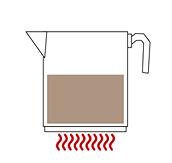
Fig. 1 - Direct Infusion
1700. In France, the grounds are isolated from the water using a cloth bag and can now be easily removed after the brew is complete.
1750. Still in France, the Drip Pot (or Filter Drip) is invented. This is the first example of percolation: hot water is poured over coffee grounds, it percolates through them (pushed by gravity), and then it passes through a filter (fig. 2). Drip Pot prevents over-extraction by limiting the amount of time that the water is in contact with the grounds, and by operating with water below its boiling point. This method will become today's America's favorite, also thanks to automatic drip machines.
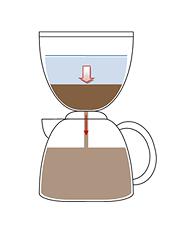
Fig. 2 - The Drip Pot
1800. A number of new methods are introduced:
- The Plunger Pot (also called French Press). An improvement over direct infusion thanks to a built in filtering system (the plunger), which pushes the grounds to the bottom through a metal mesh after the desired extraction is reached (fig. 3). The metal filter allows small particles to go through it, resulting in a more velvety coffee. The Plunger Pot operates a slow extraction that requires relatively coarse grinds.
- The Percolator. Using steam pressure, water is pushed up into a tube and forced to drop on the grounds. After percolating through, the water lands in the same container where clear water used to be. The cycle can then restart until the desired strength is reached (fig. 4). Since it operates at boiling temperature and recirculates brewed coffee through the grounds, the Percolator may over-extract. This method will become America's favorite in the 1950s.
- The Napoletana, or Flip Pot. Originally a French invention, the Napoletana is adopted by the Italians, and from the city of Naples it spreads to the entire country. The Napoletana is a variation of the Drip Pot where the water is brought to a boil in a lower chamber over a source of heat. The coffee maker is then flipped upside down, the hot water percolates through the grounds and is collected into the other chamber (fig. 5). The Napoletana will remain popular until gradually replaced by the "Moka" (see below).
- Vacuum, or Siphon Brewer (1830). Steam pressure is used to push hot water from a lower chamber into an upper one, where it mixes with ground coffee. The steam pressure sustains the column of water and the infusion can occur for as long as desired. When the device is removed from the heat, the pressure of the water column drops, allowing the infusion to go back down to the original chamber, through a metal filter (fig. 6). Despite the name, no actual vacuum is created by this coffee maker - the force that pushes the coffee through the filter is exclusively gravity. The Vacuum Brewer is appreciated in Japan because of its ceremonial character.
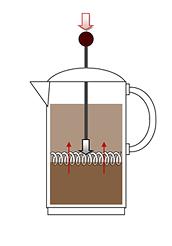
Fig. 3 - The Plunger Pot
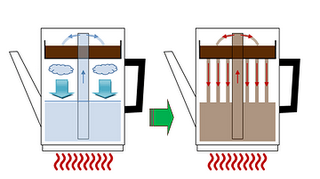
Fig. 4 - The Percolator
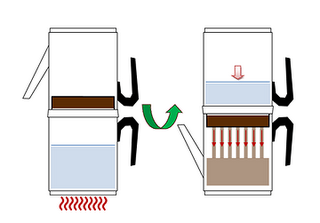
Fig. 5 - The Napoletana
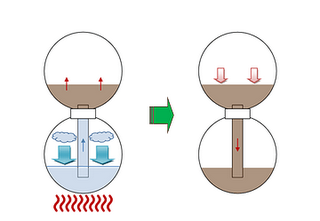
Fig. 6 - Vacuum Brewer
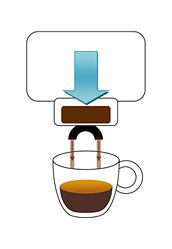
Fig. 7 - The Espresso Machine
1905. Desiderio Pavoni founds in Milan the first company that produces industrially made espresso machines. Throughout the 20th century, the espresso machine becomes more refined and new standards are determined in terms of ideal brewing parameters. The best results are obtained by heating water to 93°C, and by pumping it at 9 bars through a 7 g patty of compressed grounds (for a single-shot). The extraction takes 20 - 30 seconds and produces 30 - 40 ml of coffee (1 - 1.5 oz).
1933. The Italian "Moka" is patented by Luigi De Ponti for Alfonso Bialetti. Also known in Italy as 'caffettiera' (coffee maker), the Moka is a particular kind of percolator where the water goes through coffee grounds while still on its way up, as it is pushed into a funnel by steam pressure (fig. 8). Just like the espresso machine, the Moka operates a quick extraction and requires finely ground coffee. Since it operates at boiling temperature, it produces a slightly over-extracted coffee, which is however popular in Italian homes.

Fig. 8 - The Italian Moka
1970. Home espresso machines appear, but they have limited success because expensive and hard to operate.
1990-2000. More practical home espresso machines enter the market. These can be fully automatic (with a built-in grinder), or based on coffee pods or capsules. The new machines are more reliable and increase in popularity.
To summarize, here is a list of the various brewing methods with their distinguishing properties.
Brew Type Brewing Method Brewing Pressure Filtering Material Filtering Pressure
Greek/Turkish Direct Infusion None None N/A
Vacuum Brewing Direct Infusion None Metal Gravity
French Press Direct Infusion None Metal Manual
Drip Coffee Percolation Gravity Paper, metal, plastic Gravity
Napoletana Percolation Gravity Metal Gravity
Percolator Multiple Percolation Gravity Metal Gravity
Italian Moka Percolation Steam Metal Steam
Espresso Percolation Pump Metal Pump
Links and references:
- David Joachim, Andrew Schloss, A. Philip Handel. The Science of Good Food: The Ultimate Reference on How Cooking Works. 2008.
- Harold McGee. On Food and Cooking: The Science and Lore of the Kitchen. 2nd edition (2004).
- Turkish coffee http://en.wikipedia.org/wiki/Turkish_coffee
- Vacuum brewing http://en.wikipedia.org/wiki/Vacuum_brewer
- French press http://en.wikipedia.org/wiki/French_press
- Drip Coffee - http://en.wikipedia.org/wiki/Drip_brew
- Napoletana - http://en.wikipedia.org/wiki/Neapolitan_flip_coffee_pot
- Percolators http://en.wikipedia.org/wiki/Percolator
- Italian Moka - http://en.wikipedia.org/wiki/Moka_pot
- Espresso - http://en.wikipedia.org/wiki/Espresso
Copyright notices:
- The vintage poster used for this article (by Henri Privat-Livemont, published in Paris in 1897) is royalty-free.
- All illustrations © Quatro Fromaggio. All rights reserved.

